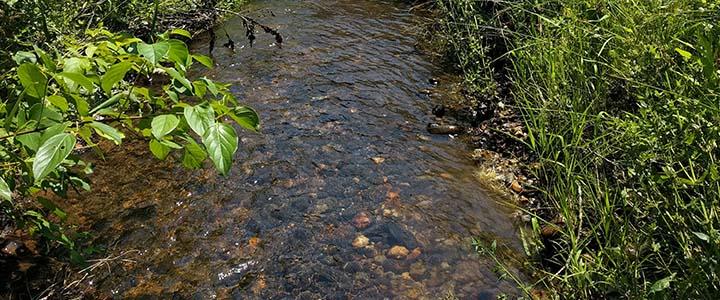
Native Brook Trout Protection Restores McQuesten Brook
In 2010, NHDES added a segment of McQuesten Brook, a tributary to the Merrimack River located in Bedford and Manchester, New Hampshire, to the Clean Water Act (CWA) section 303(d) list of impaired waters for failure to support aquatic life integrity due to insufficient dissolved oxygen (DO) concentration. The brook did not meet the state standard of 5.0 milligrams of DO per liter (mg/L). A sequence of open and closed channels and four fish passage barriers restricted the movement of brook trout and contributed to the DO impairment in this highly urbanized, 564-acre watershed.
In response, the New Hampshire Rivers Council (Council) coordinated implementation efforts recommended in the McQuesten Brook Geomorphic Assessment and Watershed Restoration Plan. Actions included bioengineered bank stabilization, floodplain restoration, stream crossing upgrades and stream daylighting that restored natural channel geometry, function and DO levels. As a result, NHDES removed this segment of McQuesten Brook from the 2018 CWA section 303(d) list of impaired waters for DO.
NHDES awarded the Council a CWA Section 319 Watershed Assistance Grant to develop the restoration plan in 2013, which ranked culvert improvements as the second most important structural recommendation in the watershed. These obstructions included: an undersized culvert that carried the brook under a road and served only one household while constricting the brook and restricting aquatic organism passage; another undersized culvert built with enough road fill to meet NHDES’ definition of a dam; and a collapsed stone culvert that completely blocked the channel and rerouted McQuesten Brook.
In May 2016, with funding assistance from the NHDES Aquatic Resource Mitigation program, work began. The Town of Bedford purchased and demolished the only house accessed by Wathen Road to the east of the brook, then removed a 35-foot segment of the road and the 36-inch undersized culvert. This innovative approach was less costly than upgrading the crossing with an appropriately sized bridge. Contractors working for the Town regraded the floodplain to match upstream and downstream elevations. To attenuate floodwaters, they created roughness on the floodplain with salvaged branches and pieces of large wood held in place by felled trees, and they seeded and planted the area to minimize erosion. The brook was diverted, and the culvert was removed in sections. Crews restored the bed with rounded cobble, and they stabilized the channel and banks with bioengineered gravel bars and crib walls made of logs, stone, and root wads. They also constructed a log and stone crib with integrated root wads at the new terminus of Wathen Road, which is designed to protect a parallel water main, and a new detention and infiltration basin and its overflow outlet to capture stormwater runoff.
Upstream and one block north of Wathen Road, where the brook was constricted, the Town of Bedford replaced an undersized 36-inch culvert at Eastman Avenue with a 15-foot open-bottom bridge. This structure is sized appropriately for aquatic organism passage and conveyance of flood flows.
Immediately upstream of Eastman Avenue, contractors removed the remnants of a collapsed historical stream crossing. This in-stream work restored stream channel dimensions, function, and fish passage along a reach of the brook that previously supported little to no fish passage. Construction work was complete in July 2016.
Concurrently, four obsolete dams were removed upstream on McQuesten Brook. This restoration effort increased aquatic organism passage throughout the watershed and connected the restored culvert sites with upstream reaches, including McQuesten Pond which was (at that time) also on the CWA section 303(d) list due to low DO. McQuesten Pond was slowly drained, and the area is now a defined wetland channel.
Removing these three fish passage impediments in 2016 re-established a more natural flow regime in this segment of McQuesten Brook, resulting in improved DO levels and lower water temperatures, which in turn created a healthier and more valuable habitat for eastern brook trout and other aquatic organisms. After restoration work, the DO threshold of 5.0 mg/L was met during a wide range of temperatures and conditions similar to those that previously resulted in low DO while the brook was impaired. In 2018, NHDES removed this river assessment unit from the CWA section 303(d) list for its DO impairment.
Subsequent brook trout population surveys completed by New Hampshire Fish and Game Department biologists revealed that trout size and population density have increased and are like those found in pristine northern New Hampshire streams.
Partners and Funding
The Council’s McQuesten Brook restoration plan and its initiative to partner with the Town of Bedford were the driving forces behind the daylighting project at Wathen Road. When the Town agreed to exceed the scope of their capital improvement plan at this site, the Council and the Town secured multiple grant resources and engaged a fluvial geomorphologist for specialized project design and construction oversight.
Funding was provided in part by Watershed Assistance Grant Funds from NHDES with $50,000 in CWA section 319 funds from the U.S. Environmental Protection Agency awarded to the Council, who served as project manager. Other funds included $345,000 in NHDES Wetland Bureau Aquatic Resource Mitigation Funds; $482,504 in matching funds from the Town Bedford’s Capital Improvement Program, including engineering and construction costs; and an additional $181,785 in matching funds from the Council, supported by dues, endowments, gifts and more. Specialized contract work was performed by Field Geology Services and Inter-Fluve, Inc.




